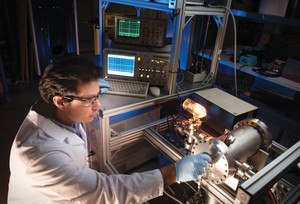 Personal archiveCosta, did his undergraduate work in 1999 at São Paulo State University (Unesp) at the Chemistry Institute in Araraquara, a city in inland São Paulo State. In 2013, US space agency NASA hired him as a researcher. In those 14 years, he became a specialist in materials for converting and storing energy.
Personal archiveCosta, did his undergraduate work in 1999 at São Paulo State University (Unesp) at the Chemistry Institute in Araraquara, a city in inland São Paulo State. In 2013, US space agency NASA hired him as a researcher. In those 14 years, he became a specialist in materials for converting and storing energy.
During his early undergraduate years in chemistry, Costa’s advisor was José Arana Varela (1944-2016), full professor at the Unesp Chemistry Institute in Araraquara and chief executive officer of FAPESP from 2012 to 2016. Costa completed his master’s degree in 2004 and his PhD in 2008, both at the Nuclear and Energy Research Institute (IPEN) in São Paulo, where he studied the synthesis and structural characterization of electroceramics.
In 2007, under the orientation of physicist Reginaldo Muccillo from the IPEN and chemist Alexandra Navrotsky from the University of California (UC), Davis campus, in the United States, Costa revised his doctoral research project to study the chemical stability of nanoparticles of materials used in converting and storing energy at the UC Davis Chemistry Department. The proposal was accepted, and in 2007 Costa traveled to the United States, where he spent one year.
Upon his return to Brazil, he was invited back to UC Davis as a researcher. “I accepted the offer and worked in the United States for four years,” he says. “During that period, I delved further into my studies on the chemical stability of nanoparticles of different materials for storing and converting energy.” In one of his research projects, he developed a material capable of neutralizing radioactive waste and making it harmless to the environment. In 2012, this discovery won him a position as scientist at the Los Alamos National Laboratory in the state of New Mexico.
In 2013, Costa submitted another research project to apply for a position at NASA’s Glenn Research Center. “I wanted to conduct research on the chemical stability of atmospheres of planets that are in the early stages of formation,” he says. Costa, then 37, was hired and today he is in charge of the Venus Chamber at Glenn. “I study the corrosive effects of Venus’s atmosphere on all types of materials,” he explains. “The idea is to develop new materials to build a probe capable of remaining on the surface of Venus for months or years.”
Costa also works on designing ceramic materials to cover the surface of the inner portion of aircraft turbines so that they can better withstand the corrosive effects of sand particles, a common problem during takeoff. As part of another line of work, he is a member of a group that develops materials for ion thrusters, a type of motor that uses electricity to create atomic particles charged with energy, commonly used to direct satellites in orbit around the Earth.
Republish